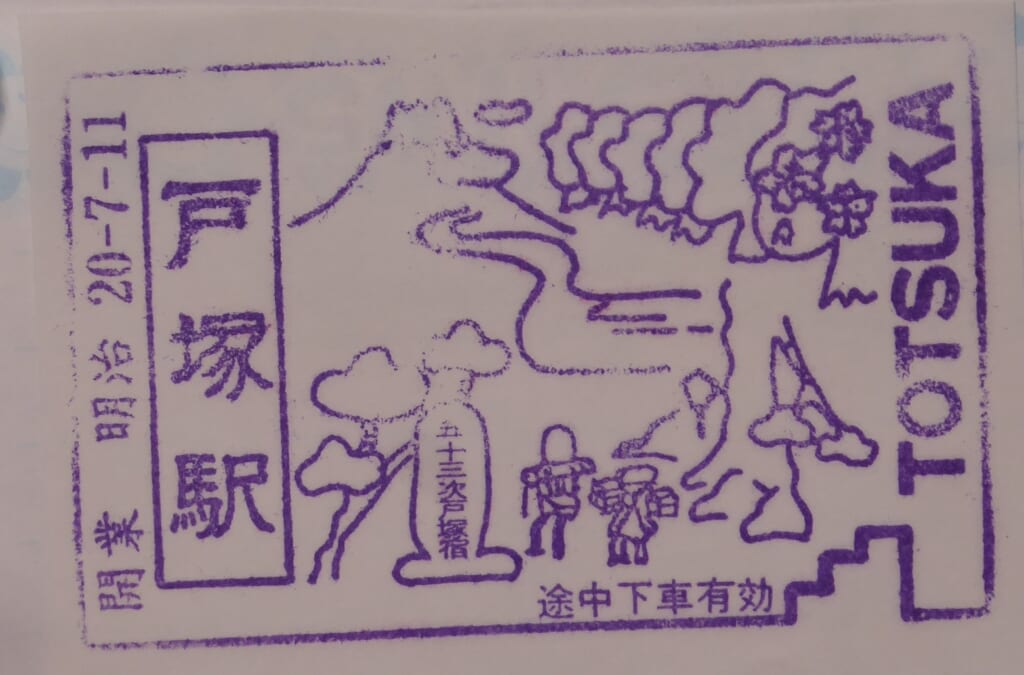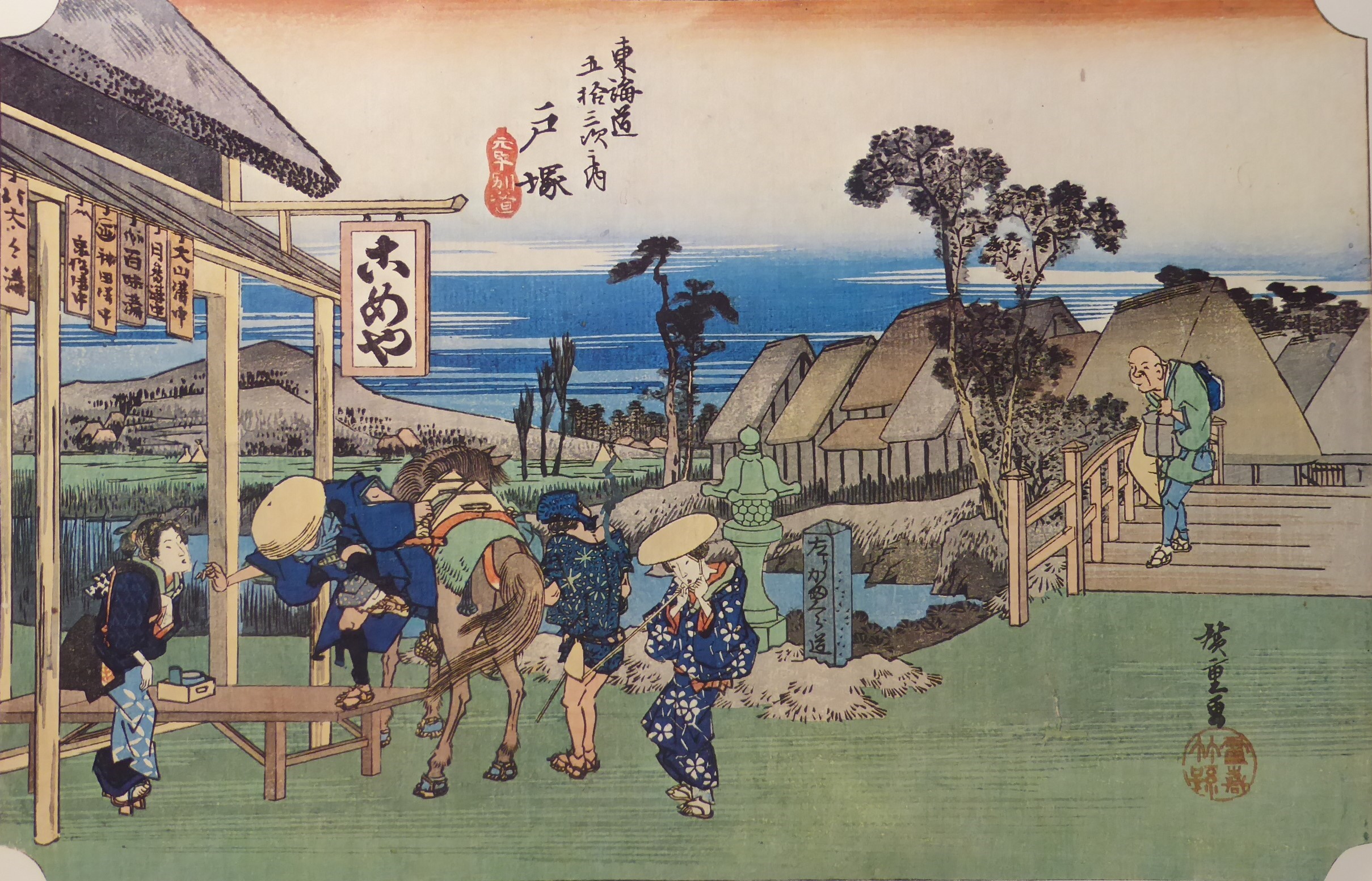Explanation of the Fifty-three Stations of the Tokaido 6 Totsuka
7.9km from Fujisawa to Totsuka 35°23′42.1″N 139°31′47.5″E
Totsuka is the fifth post station on the Tokaido.
It became a post station three years after the neighboring stations of Fujisawa and Hodogaya were established in 1601.
Totsuka is the fifth post station town from the starting point of Nihonbashi.
It is 42km away from Nihonbashi.
It was the perfect place for travelers to stop by when they left Edo in the morning.
It was a very lively post station as a fork in the road to Kamakura and the road to Mt. Oyama for pilgrimage.
Fujisawa was the next post station after Hodogaya, but inns also increased in Totsuka.
Fujisawa was the post station that was afraid of losing customers, but Totsuka was officially recognized as a post station by the shogunate.
The old Tokaido road in Totsuka ward ran from north to south, with a total length of about 11.7 km.
Totsuka-shuku is an area of about 2.3 km sandwiched between the remains of two mitsuke, the Edo-kata mitsuke site and the Kamigata mitsuke site, and is still bustling as the center of Totsuka ward.
It consists of three towns: Yoshida-cho, Totsuka-cho, and Yabe-cho.
The mitsuke are in front of the current AEON in Yoshida-cho and Osakashita in Totsuka-cho, and there are mileposts in Shinano-cho and Harajuku-cho.
It was a strategic point where the Oyama-do, Kamakura-kaido, and Atsugi-kaido roads intersected.
When the black ships arrived at the end of the Edo period, refugees fled here.
In 1843, the post town had two honjin , three waki-honjin , 75 hatago, a total of 613 houses, and a population of 2,906.
It consists of three towns: Yoshida-cho, Totsuka-cho, and Yabe-cho.
At the site of Sawabe Honjin, there is Haguro Shrine, which was the house deity.
The site of Uchida Honjin is now Totsuka Post Office.
Mitsuke was located in front of the current Aeon in Yoshida-cho and Osakashita in Totsuka-cho (in front of the bus stop), and mileposts remain in Shinano-cho and Harajuku-cho.
It was a strategic point where the Oyama Road, Kamakura Kaido, and Atsugi Kaido intersected.
It is said that refugees fled here when the black ships arrived at the end of the Edo period.
“Iza Kamakura” is an idiom used when fired up in an emergency.
During the Kamakura period, samurai were determined to “rush to Kamakura” if a major crisis occurred in the shogunate.
A summary of the Tale of Hachinoki (Sano City).
About 700 years ago.
A traveling monk was walking along a snowy road in Yamamoto Village (present-day Sano City).
This traveling monk was none other than Hojo Tokiyori, the regent of the Kamakura shogunate, in disguise.
Soon the monk found a poor-looking farmhouse.
It was a poor house where only two people lived, a couple who struggled to make ends meet.
As the night drew on, the firewood ran out and the fire in the hearth began to die out.
The owner brought a potted tree and raised his axe.
He offered heartwarming hospitality to the unknown traveling monk.
The owner was prepared to rush to Kamakura before anyone else if anything should happen to the Lord of Kamakura.
In the spring after the new year, Tokiyori rewarded the samurai for being the first to rush to Kamakura when a major incident occurred in Kamakura.
In fact, the phrase “Let’s go to Kamakura” does not appear in “Hachi no Ki.”
The senryu poem “Sano no Uma Totsuka no Saka de Twice Fell” (Sano’s Horse, Totsuka no Saka de Twice Falls), which is based on Totsuka-juku, is a parody of the Tale of the Hachi no Ki.
It means that an old horse came running to Kamakura, but fell at Totsuka, just before Kamakura.
① “Hoeido version”
A view of Yoshida Bridge on the Kasuo River.
At the foot of the bridge there is a sign that says “Left Kamakura Road”.
On the left there is an inn with a large sign that says “Komeya”.
There is a sign hanging under the eaves of the inn.
“Ooyama Kochu”, “Tsukishima Kochu”, “Hyakumi Kochu”, “Kanda Kochu”, “Kyobashi Kochu”, “Daidai Kochu”.
The sign is a sign that you can stay safely.
This inn does not have women who serve food, so women, children, and the elderly can stay safely.
② “Gyosho version”
A view of Hacho Namiki, a little past Totsuka-juku.
The roofs of the inn can be seen at the bottom of the slope.
It depicts the journey of horses and palanquins.
The pine trees stretching out towards the center are impressive.
③ “Reisho version”
This is a view of Hacho-namiki a little past Totsuka-juku.
You can see half of Mt. Fuji to the right.
It depicts the state of travelers.
④ “Hokusai version”
A morning view of an inn.
The Great Buddha of Kamakura at Kotoku-in Temple is depicted in the background.
However, the Great Buddha seems too big.
The distance to the Great Buddha is also 13km.
⑤ “Travel image”
The hotel where we stayed.
⑥ “Stamp image”
This is a stamp from JR Totsuka Station.
Hoeido version
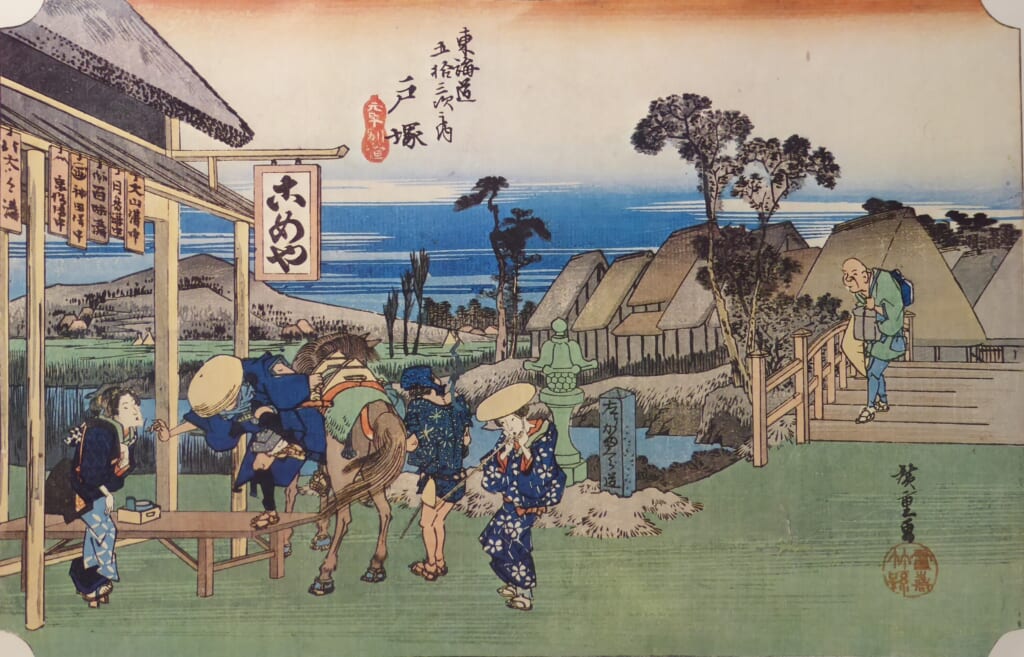
Gyousyo version
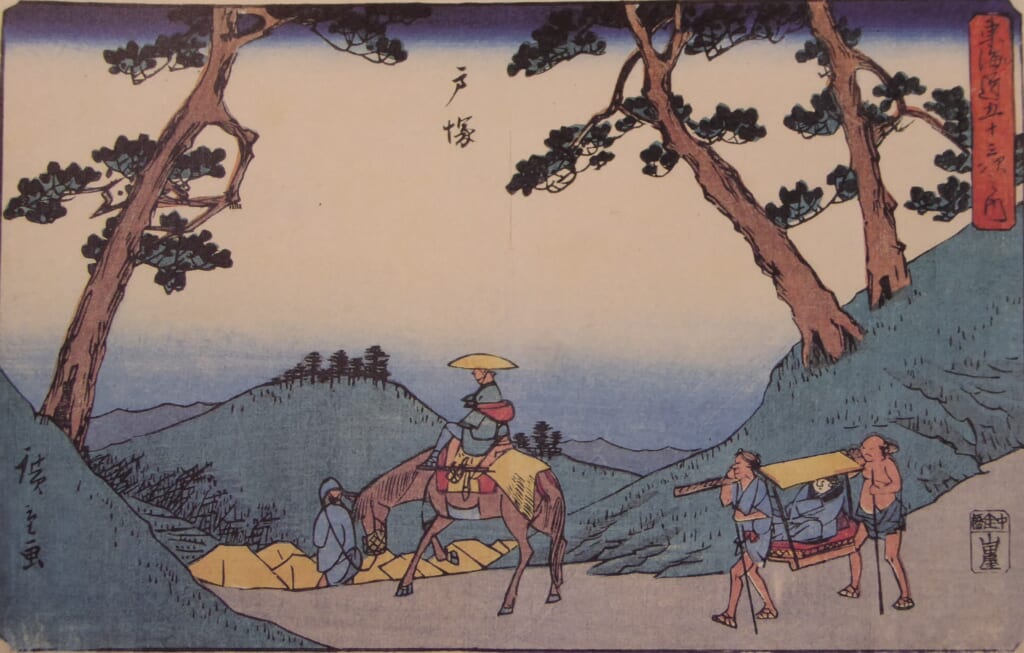
Reisho version
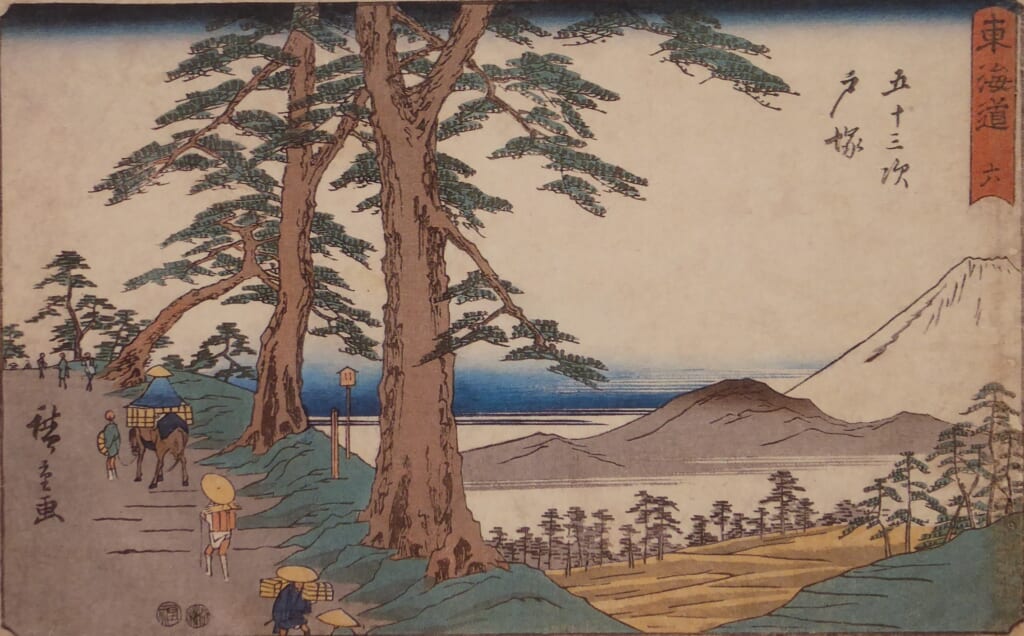
Hokusai version
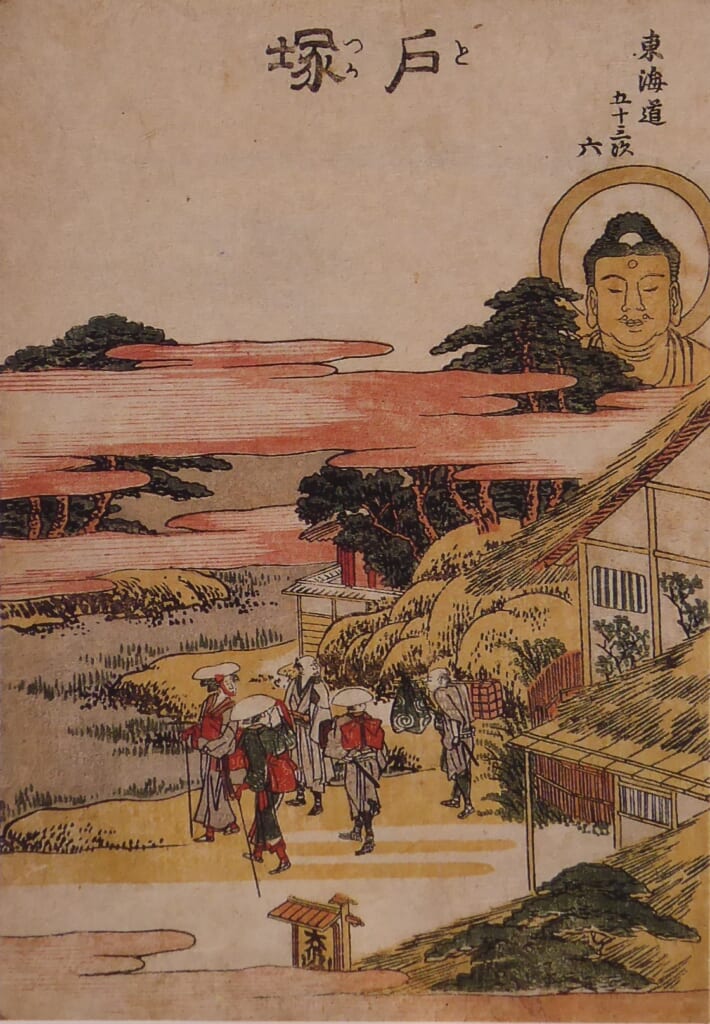
Travel image
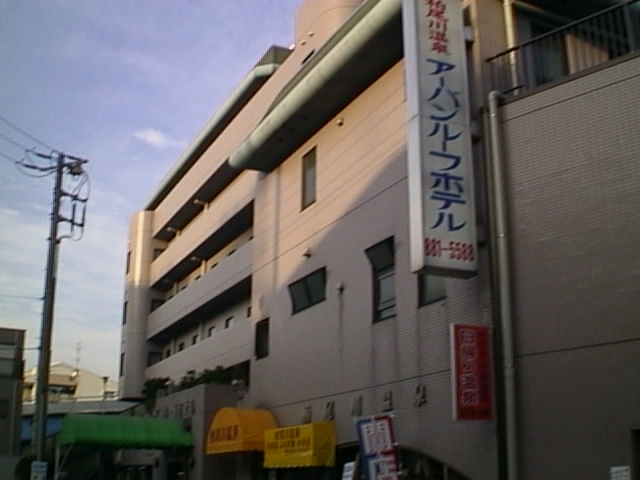
Stamp image
